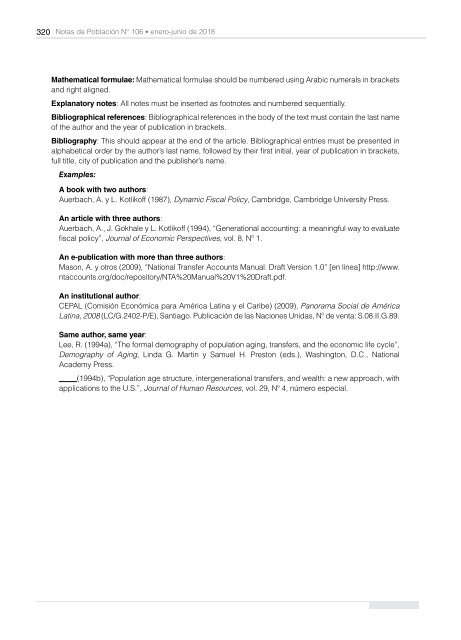Notas de Población N° 106
El número 106 de Notas de Población está conformado por 10 artículos, en cuya elaboración han participado 21 colaboradores. Los artículos abordan diversos temas de investigación relacionados con la mortalidad, el transnacionalismo migratorio y la fecundidad de las migrantes, así como la fecundidad adolescente, el femicidio, la migración de retorno, la segregación en el espacio urbano y el dividendo demográfico.
El número 106 de Notas de Población está conformado por 10 artículos, en cuya elaboración han participado 21 colaboradores. Los artículos abordan diversos temas de investigación relacionados con la mortalidad, el transnacionalismo migratorio y la fecundidad de las migrantes, así como la fecundidad adolescente, el femicidio, la migración de retorno, la segregación en el espacio urbano y el dividendo demográfico.
You also want an ePaper? Increase the reach of your titles
YUMPU automatically turns print PDFs into web optimized ePapers that Google loves.
320 <strong>Notas</strong> <strong>de</strong> <strong>Población</strong> <strong>N°</strong> <strong>106</strong> • enero-junio <strong>de</strong> 2018<br />
Mathematical formulae: Mathematical formulae should be numbered using Arabic numerals in brackets<br />
and right aligned.<br />
Explanatory notes: All notes must be inserted as footnotes and numbered sequentially.<br />
Bibliographical references: Bibliographical references in the body of the text must contain the last name<br />
of the author and the year of publication in brackets.<br />
Bibliography: This should appear at the end of the article. Bibliographical entries must be presented in<br />
alphabetical or<strong>de</strong>r by the author’s last name, followed by their first initial, year of publication in brackets,<br />
full title, city of publication and the publisher’s name.<br />
Examples:<br />
A book with two authors:<br />
Auerbach, A. y L. Kotlikoff (1987), Dynamic Fiscal Policy, Cambridge, Cambridge University Press.<br />
An article with three authors:<br />
Auerbach, A., J. Gokhale y L. Kotlikoff (1994), “Generational accounting: a meaningful way to evaluate<br />
fiscal policy”, Journal of Economic Perspectives, vol. 8, Nº 1.<br />
An e-publication with more than three authors:<br />
Mason, A. y otros (2009), “National Transfer Accounts Manual. Draft Version 1.0” [en línea] http://www.<br />
ntaccounts.org/doc/repository/NTA%20Manual%20V1%20Draft.pdf.<br />
An institutional author:<br />
CEPAL (Comisión Económica para América Latina y el Caribe) (2009), Panorama Social <strong>de</strong> América<br />
Latina, 2008 (LC/G.2402-P/E), Santiago. Publicación <strong>de</strong> las Naciones Unidas, Nº <strong>de</strong> venta: S.08.II.G.89.<br />
Same author, same year:<br />
Lee, R. (1994a), “The formal <strong>de</strong>mography of population aging, transfers, and the economic life cycle”,<br />
Demography of Aging, Linda G. Martin y Samuel H. Preston (eds.), Washington, D.C., National<br />
Aca<strong>de</strong>my Press.<br />
(1994b), “Population age structure, intergenerational transfers, and wealth: a new approach, with<br />
applications to the U.S.”, Journal of Human Resources, vol. 29, Nº 4, número especial.


















